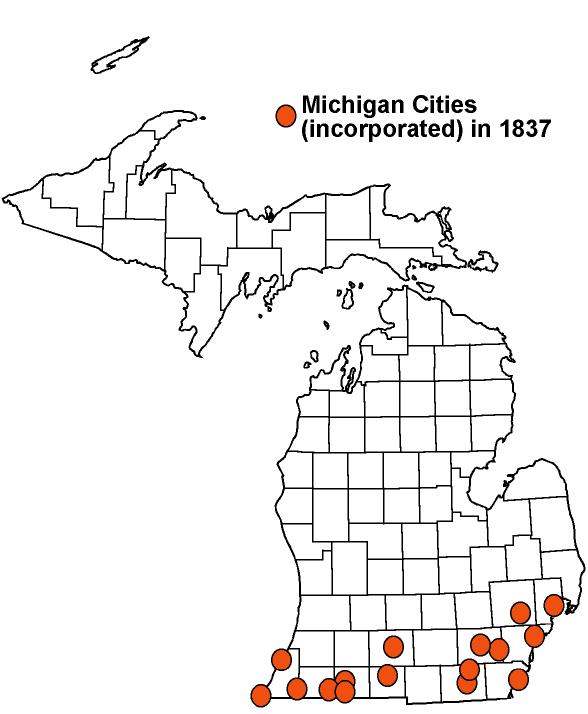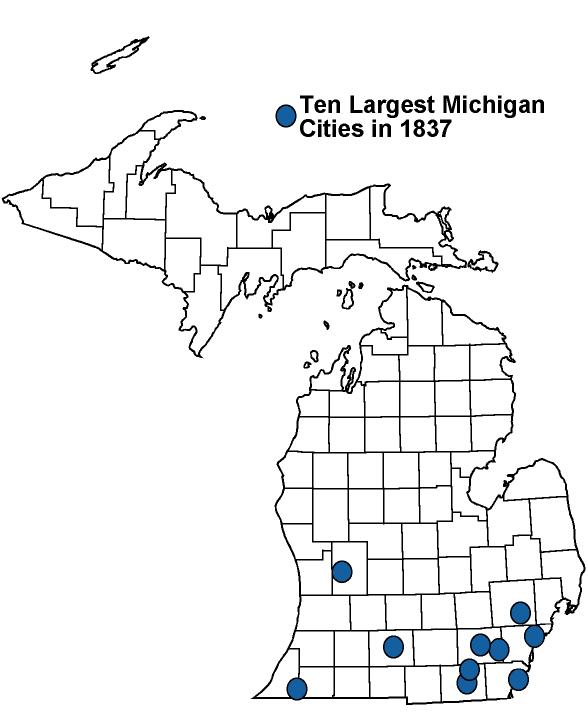EARLY CITIES
In the early 1800's, no other town in Michigan approached Detroit in size or importance.
In fact, it was the only incorporated city in Michigan when the state was admitted to the
Union in 1837. Fifteen villages had been incorporated by 1837: Monroe(1827), Ypsilanti
(1832), Ann Arbor (1833), Niles, Adrian, Pontiac, St. Joseph, Tecumseh, Centreville,
Constantine, White Pigeon, New Buffalo, Marshall, Mount Clemens, and Coldwater (see map
below).

Source: Michigan State University, Department of Geography
The state census of 1837 lists the population of the townships in the various counties,
but not the towns proper. Estimating the size of the towns from the number of inhabitants
of the townships in which they were located, one may conclude that the ten largest towns
in Michigan in 1837, in decreasing order of their size, were Detroit, Ann Arbor, Monroe,
Tecumseh, Ypsilanti, Adrian, Marshall, Pontiac, Grand Rapids, and Niles (see map below).

Source: Michigan State University, Department of Geography
Town location factors
The location of towns was due to a variety of factors. Many
grew up along the Chicago Road (Ypsilanti, Coldwater, Jonesville, White Pigeon) and the
Territorial Road (Jackson, Marshall, Battle Creek, Kalamazoo). A town sometimes developed
around a tavern on one of these highways (Clinton) or where a stream could be most easily
forded (Kalamazoo). Marshall was located at the head of navigation on the Kalamazoo River.
Towns often grew up around early forts (Saginaw, Niles) or trading posts (Ypsilanti). Some
towns were the result of the work of promoters who hoped to profit from the sale of town
lots (Ann Arbor, New buffalo, Albion). A town was apt to grow up at a promising mill site
(Galesburg), or at a favorable point on an important river. Constantine was situated on
the St. Joseph River and became an important shipping point for grain; Grand Rapids, as
its name indicates, grew up at a point on the Grand River where rapids interrupted travel.
The growth of some towns was promoted by the location of a land office (Monroe, White
Pigeon, Kalamazoo, Ionia, Flint).
When selecting a possible site for a city, from the vast wilderness
that was Michigan Territory, the first question the "investor" would ask was,
"What service will my proposed town supply that will attract farmers?" If the
town could pull in the farmers, it would attract an urban population who would buy the
town lots---and that was where the money was. On the Michigan frontier, the urban services
most desired by the agricultural population were: 1) grinding grain and sawing timber, 2)
governmental service, and 3) retailing. The second question, and most critical for the
success of his venture, which the speculator had to ask was, "Where?" Most of
the towns founded on the Michigan farming frontier were located in places perceived by
their promoters to best supply one of these services: a water power site for a grist and
saw mill, a central location within the county for the seat of government, or the center
of a dense farming population for a shopping town.
Among the first services desired by the agricultural settlers were the
milling of grain and the sawing of lumber. Although those settlers on the American
frontier who came from the south were apparently satisfied with eating corn bread, this
was not the case in Michigan. Here the Yankee settlers wanted, as soon as possible, to
exchange their "Johnnycake" for white (wheat) bread. The log cabin, so useful on
the frontier, was also soon given up for one made from sawed lumber. These services,
grinding wheat and sawing lumber, could most easily be supplied where the force of falling
water could be harnessed to supply the power. Thus, a "water privilege", as such
power sites were called, was one of the most important type of locations where towns were
founded. A close examination of the sites of many of the interior towns in the southern
four tiers of counties in Michigan will reveal the stream upon which they were formed.
During these frontier years, Michigan was visited by many speculators
spying out the valuable waterpower sites where towns might grow up. One, who visited
Kalamazoo County even had a mathematical formula which he used to ascertain the power of a
stream. That such sites were to be important in the formation of the towns in the interior
was pointed out as early as 1819 by the editors of the Detroit Gazette when, in describing
what was to become Oakland County, they remarked: "Mills, which may be considered as
the buds which bloom into villages in new countries, can soon be erected...." And, in
its continuing effort to publicize the advantages of the interior, the paper reported in
1826 that on the tributary streams of the "Canamazoo River" were many excellent
mill-sites. Such a location was chosen for one of the county’s first towns.
Although a large proportion of the towns founded in the agricultural
interior were on waterpower sites, the most sought after location was that of the county
seat. Here would be the political, economic, and social focus of the county.
The other logical situation for a town-site speculation during the
early years of settlement in Michigan was in the center of a dense agricultural
population. This farming settlement, as it grew, would require the retail services that a
village could supply. In Kalamazoo County, for example, Prairie Ronde was for many years
the most densely settled area. It was the location of the county’s first settlers and
by 1831 had several hundred people on its border. Such a situation called for and resulted
in a village being founded at the "Big Island" in the center of that prairie.
Town characteristics
By the close of the territorial period, those towns that had been
incorporated as villages had local governing bodies to meet the needs of citizens for
regulations to control livestock, to provide for the fighting of fires, and to maintain
law and order. In the unincorporated towns, local government was in the hands of township
officials.
Most of the towns had one or more churches, a school, several general
stores, a sawmill, and a gristmill. Streets were deep in mud during the spring season and
dusty in summertime. Lawyers and doctors maintained offices, often serving the people of
an extensive area. In some towns promoters set aside squares for public parks, and since
the people who built the towns were largely Yankees, they tended to use the New England
village as a model.
Town names
The names of the towns were selected from
many different sources. Indian names, such as Kalamazoo, Pontiac, Tecumseh, and Saginaw,
were common. Some took their names from geographical features, for example Grand Rapids,
Saline, and Coldwater. The founder’s name was often utilized, as was the case with
Kalamazoo, originally named Bronson after its founder, Titus Bronson. The present Bronson
in Branch County was named for its founder, Jobez Bronson. Dexter took its name from
Samuel Dexter. New England names, such as Quincy, Vermontville, and Lawrence, were
popular, and the New York influence was reflected in towns such as Utica and Rochester.
Monroe and Jackson followed the practice of honoring presidents, while Marshall was named
for Chief Justice John Marshall. Adrian, Constantine, and Homer derived their names from
classical antiquity. Niles was named for the publisher of the popular eastern news
publication, Nile’s Weekly. Among the more unusual name selections are those
of the neighboring communities of Ann Arbor and Ypsilanti. The former derived its name,
apparently, from the name of the wives of two founders, both named Ann, while the latter
was named after Demetrius Ypsilanti, a hero of the Greek War of Independence, which had
excited much interest in the United States at the time this town was laid out in 1823-24.
The following images provide a flavor of what early Traverse City was like.
FRONT STREET:
Source: Image
Courtesy Michigan History Magazine
BOARDMAN RIVER ELECTRIC COOPERATIVE:
Source: Image
Courtesy Michigan History Magazine
HANNAH PARK:
Source: Image
Courtesy Michigan History Magazine
UNION STREET BRIDGE:
Source: Image
Courtesy Michigan History Magazine
These and other towns were of great importance to early settlers. The story of their
development is as significant as that of the pioneer farmers. In 1837 the majority of
Michiganians lived on farms, but before the century
ended, the number of city dwellers was rapidly approaching that of those living in rural
surroundings.
Some of the text on this page was adapted from Dunbar and May's Michigan A History of the Wolverine State, and from a 1972 article on "Early Town-Site Speculation in Kalamazoo County" by B.C. Peters, in Michigan History magazine.
This material has been compiled for educational use only, and may not be reproduced without permission. One copy may be printed for personal use. Please contact Randall Schaetzl (soils@msu.edu) for more information or permissions.